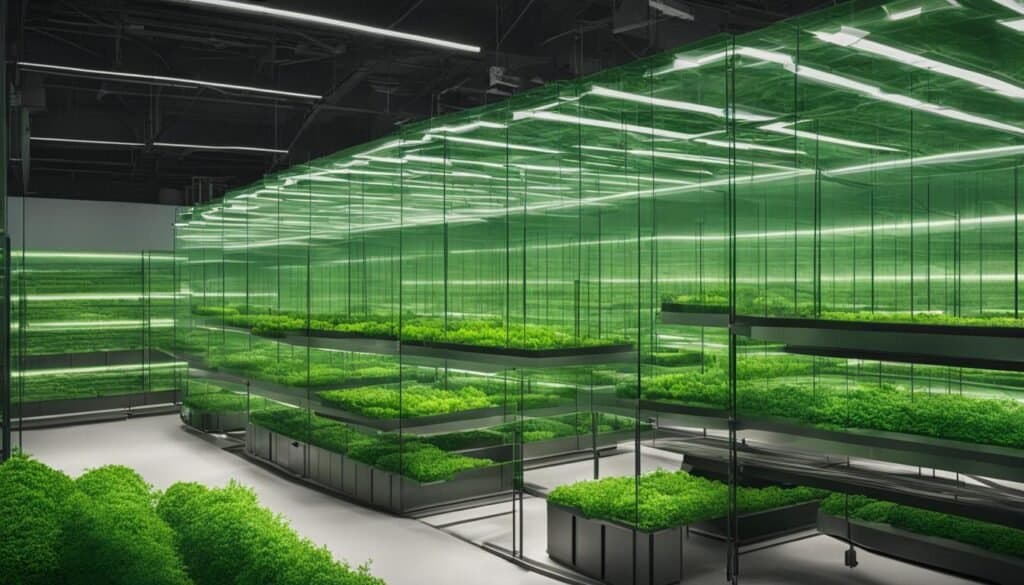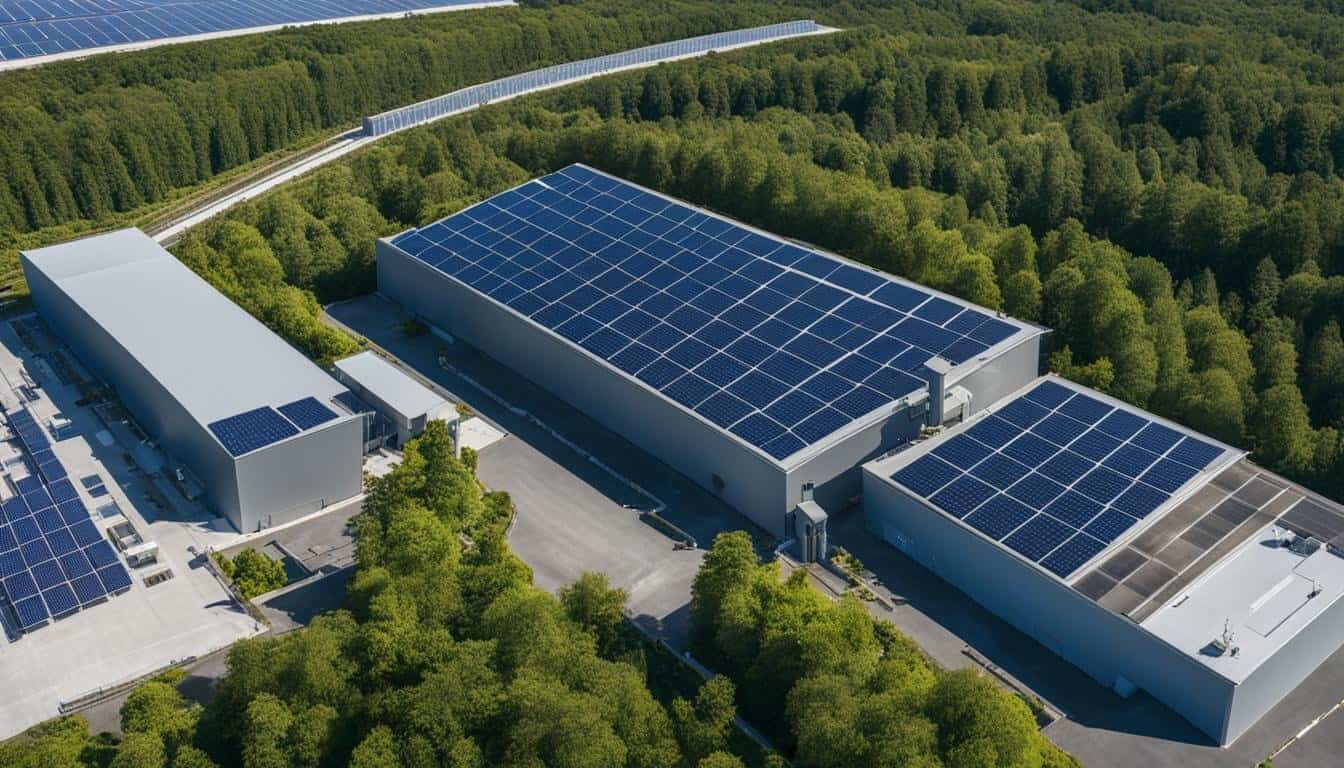As we strive towards a green future, the manufacturing sector plays a pivotal role in our transition to more sustainable manufacturing for eco-friendly products. Recognizing the need for a shift in the industry, I have personally witnessed the growing importance of sustainability matters, with many companies now focusing on producing eco-friendly products to reduce their overall environmental impact.
This is no easy task, as manufacturers face significant challenges such as resource depletion, greenhouse gas emissions, and waste generation. However, as I explore the benefits of sustainable manufacturing, it becomes clear that the intrinsic value of a greener approach outweighs these hurdles.
Key Takeaways
- The importance of sustainable manufacturing practices in achieving a green future
- Challenges faced by the industry in adopting sustainable practices
- Real-world examples of companies embracing green industry practices
- Benefits of transitioning to sustainable manufacturing, including cost savings and brand reputation improvement
- The role of consumers in driving demand for eco-friendly products and practices
- Emerging technologies and innovations that support sustainability in manufacturing
- Long-term benefits of adopting sustainable practices, such as increased competitiveness and market growth
The Imperative Role of Sustainability in Modern Manufacturing
The urgency of sustainability has been acknowledged by manufacturing industries worldwide, given the global climate concerns. It is now more important than ever for businesses to adopt sustainable manufacturing practices to modernize their operations, meet the expectations of eco-conscious buyers, and support green initiatives.
Regardless of their size, manufacturers who embrace sustainable initiatives can empower their workforces and play a significant role in safeguarding the environment.
The Union of Concerned Scientists advocates for rapid vehicle electrification and the development of an extensive charging infrastructure to support electric vehicles, alongside a rapid transition of the power grid to renewable energy. Low-Carbon Pathways for Transportation
Sustainable practices bring multiple advantages, including cost reductions, environmental protection, improved brand recognition, new customer and employee attraction, tax credit savings, and a positive contribution to the economy. Moreover, these practices reflect a strong commitment to social responsibility and corporate social responsibility, driving manufacturers to implement green policies that mitigate climate change and promote environmental consciousness.
- Cost reductions
- Environmental protection
- Improved brand recognition
- New customer and employee attraction
- Tax credit savings
- Positive contribution to the economy
Manufacturers that swiftly adapt to these new sustainable manufacturing practices can gain a competitive edge in the market and cater to the growing number of eco-conscious consumers. As the importance of sustainability grows, manufacturers must consider investing in greener technologies and re-evaluating their existing business practices to ensure their long-term success in an environmentally-conscious economy.
| Practice | Benefit |
|---|---|
| Energy-efficient technologies | Reduced energy consumption and costs |
| Green supply chain management | Minimized environmental impact and enhanced brand value |
| Recycling and waste management | Less resource consumption and waste generation |
| Water conservation techniques | Preservation of water resources and reduction in water costs |
In conclusion, manufacturers that embrace sustainable manufacturing practices contribute significantly towards creating a greener future. By prioritizing corporate social responsibility, aligning green policies and practices, and being environmentally conscious, businesses can secure long-term success while upholding their social responsibility to safeguard the environment for generations to come.
Embracing Energy Efficiency: A Win for the Environment and Industry
As environmental concerns continue to take center stage, sustainable manufacturing is quickly becoming vital for both the industry and our planet. By tapping into renewable energy sources and implementing energy-efficient technologies and practices, manufacturers can reduce their energy consumption and environmental impact, contributing to a greener future.
Investing in Renewable Energy Sources
One significant way to boost sustainable manufacturing is by investing in renewable energy sources like solar power and wind power. Harnessing these green energy alternatives not only provides clean energy to manufacturing facilities but also helps reduce greenhouse gas emissions, which are harmful to the environment. Additionally, using renewable energy sources effectively lowers energy costs, further demonstrating the advantages of embracing such eco-friendly solutions.
According to the International Renewable Energy Agency, using renewables could save the industry around USD 200 billion in energy costs annually by 2035.
Adopting Energy-efficient Technologies and Practices
Another crucial aspect of sustainable manufacturing is the adoption of energy-efficient technologies and practices. By upgrading to more efficient equipment and utilizing smart manufacturing technologies, manufacturers can significantly reduce their overall energy consumption.
Lean manufacturing principles also play an essential role in minimizing energy usage and fostering a culture of eco-efficiency. Implementing these principles leads to more streamlined operations and effective use of energy and natural resources, ultimately resulting in sustainable energy practices across the industry.
- Perform regular energy audits to identify improvement opportunities.
- Invest in smart manufacturing technologies that optimize energy consumption.
- Train employees on energy-saving practices and encourage their participation in sustainability programs.
- Incorporate energy-efficient lighting and heating systems in manufacturing facilities.
Manufacturers that prioritize both renewable energy sources and energy-efficient technologies can expect substantial long-term benefits, including cost savings, a reduced carbon footprint, and positive brand perception among eco-conscious customers. In addition, these sustainable solutions can also pave the way for unparalleled business growth and development.
Revolutionizing Material Use with Eco-Friendly Alternatives
A revolution in material usage is key to sustainable manufacturing. By prioritizing eco-friendly alternatives—such as recycled plastics, biodegradable materials, and responsibly sourced elements—manufacturers reduce their environmental impact. Advanced materials and processes, including 3D printing and nanotechnology, contribute to resource conservation and waste reduction, echoing the industry’s shift towards a more sustainable approach to material usage.
With the growing importance of sustainable materials and the adoption of green chemistry principles, the manufacturing industry are seeking non-toxic materials and innovative methods that enhance the sustainability of their processes and products. In this regard, let’s explore some of the prominent eco-friendly alternatives that enable manufacturers to minimize their environmental footprint:
- Bioplastics: By replacing traditional plastics with bioplastics, manufacturers can minimize both their dependence on fossil fuel resources and the environmental impacts of plastic waste. Biodegradable and compostable plastics, such as polylactic acid (PLA) and polyhydroxyalkanoates (PHA), are ideal for single-use items and packaging materials, minimizing potential harm to ecosystems and wildlife.
- Recycled Materials: Utilizing recycled materials like metals, paper, and plastic not only conserves valuable resources but also reduces the energy consumption associated with virgin material extraction and processing. Manufacturers also benefit from cost savings and improved environmental credentials.
- Material Optimization: Through efficient design and cutting-edge manufacturing technologies, businesses can optimize their material usage, reducing waste and the overall amount of resources consumed. Techniques like additive manufacturing, or 3D printing, allow for complex geometric designs and reduced material input without compromising strength or durability.
- Non-Toxic Materials: Embracing non-toxic materials like natural fibers, water-based adhesives, and solvent-free coatings can lessen the accumulation of hazardous waste and limit harmful emissions. These environmentally friendly substitutes represent a crucial step in minimizing the industry’s impact on human health and ecosystems.
“A truly sustainable manufacturing process should not only focus on minimizing the environmental impacts of its products during usage but also on the materials utilized and the end-of-life disposal or recycling options.”
Moving towards eco-friendly alternatives in material usage is not merely an idealistic goal for manufacturers; it’s an essential step that can deliver tangible benefits against the pressing environmental challenges faced today. The adoption of sustainable materials and green chemistry practices shows businesses’ commitment to environmental stewardship — a commitment that can drive innovation, resilience, and competitive advantage in a rapidly evolving market.
Waste Reduction and Recycling: Keys to Minimizing Environmental Impact
Implementing zero waste initiatives is vital in combating waste generation inherent in the manufacturing sector. By maximizing material utilization and encouraging internal recycling programs, manufacturers can approach zero-waste goals—dramatically minimizing their environmental footprint. Strategies such as challenging employees to zero-waste actions, incorporating recycling bins, and optimizing processes for waste reduction align with eco-conscious practices and regulatory adherence.

Implementing Zero Waste Initiatives
A successful zero waste initiative begins with a thorough assessment of waste generation sources in the production process. By identifying major waste producers, manufacturers can then implement targeted strategies for waste reduction and recycling.
“In nature, everything has a purpose. There is no waste. Why should we design a system that has waste intended as part of it? Everything can be repurposed, reused or recycled.” – Katherine McCormick, Sustainability Expert
Some practical steps manufacturers can take to implement zero waste initiatives and minimize environmental impact include:
- Prioritizing waste prevention through improved resource management.
- Developing efficient production practices that maximize material utilization.
- Establishing internal recycling programs for materials such as paper, cardboard, and plastics.
- Encouraging employees to adopt eco-conscious practices like using reusable containers instead of disposable ones.
- Optimizing packaging design to reduce material usage and waste generation.
- Collaborating with suppliers and vendors who share similar waste reduction and recycling goals.
Here’s an example of successful waste reduction initiatives, comparing two different manufacturing techniques:
| Traditional Manufacturing | Zero Waste Manufacturing |
|---|---|
| Materials and resources used inefficiently, generating significant waste. | Material optimization and resource-efficient technologies minimize waste generation. |
| Landfills and incinerators burdened with excess solid waste. | Waste repurposed or recycled, significantly reducing the need for landfill space and incineration. |
| Higher costs from raw material procurement and waste disposal. | Cost savings achieved through reduced waste management expenses and efficient resource utilization. |
| Production processes not optimized for eco-friendliness or sustainability. | Processes designed to minimize waste generation, recycle resources, and support renewable energy. |
Manufacturers can achieve measurable results in environmental impact minimization through deliberate waste reduction efforts and by championing sustainable innovation. With a commitment to zero waste initiatives and eco-conscious practices, industry players can reshape their manufacturing processes, fulfill regulatory requirements, and make a lasting difference for generations to come.
Adopting the Circular Economy and Closed Loop Systems
The circular economy offers a groundbreaking shift from traditional linear manufacturing, promoting the establishment of closed loop systems that prioritize the longevity, reuse, and recycling of materials and products. By recovering and repurposing resources, companies that embrace circular economy practices demonstrate their commitment to sustainability, reducing the need for extracting new resources. Closed loop systems contribute to more resource-efficient and environmentally-friendly manufacturing processes.

Some key aspects to consider when adopting a circular economy approach include:
- Designing products with longevity and repairability in mind
- Optimizing resource use during production
- Incorporating recycled materials into new products
- Developing take-back programs for used products
- Creating business models that prioritize product-as-a-service
These strategies contribute to creating a more sustainable production system that benefits both the environment and companies by reducing waste and costs, thereby fostering innovation and market competitiveness.
“The circular economy is the ultimate approach to prolonging product lifecycles and maximizing resource efficiency, making it an essential factor in sustainable manufacturing.”
Several global companies have successfully implemented circular economy principles into their operations. For example, Apple’s recycling program called Apple Trade In takes back old devices for recycling and repurposing, which not only minimizes electronic waste but also helps the company to recover valuable resources. Another example is Patagonia, which offers a repair and reuse program for their outerwear products, increasing their longevity and reducing waste generation.
The Department of Energy highlights that reducing energy use is crucial in the fight against climate change, and energy-efficient homes and buildings can help in this effort. Energy Efficiency: Buildings and Industry
It is crucial for manufacturers to collaboratively engage with all stakeholders, including suppliers, customers, and policymakers, to facilitate the widespread adoption of circular economy and closed loop systems. As environmental concerns continue to grow, manufacturers need to be proactive and resourceful in implementing sustainable practices throughout the entire production process.
₁
Green Engineering: The Rise of Bioplastics and Sustainable Composites

The increasing global focus on environmental stewardship has led to significant advancements in green engineering, primarily the development of bioplastics and sustainable composites. These new, eco-friendly materials offer a promising alternative to traditional petroleum-based plastics, helping to reduce greenhouse gas emissions and conserve resources.
Developing Plant-based Materials for Manufacturing
One of the most notable innovations in green engineering is the creation of plant-based materials, such as polylactic acid (PLA) and starch-based plastics. Unlike conventional plastics, plant-based materials are derived from renewable resources such as corn and sugarcane. As a result, they contribute to resource conservation and significantly lower the ecological impact of manufacturing processes.
By switching to plant-based materials, manufacturers can reduce both their dependency on fossil fuels and the pollution resulting from the production and disposal of petroleum-based plastics.
Advancing Compostability and Recyclability
Another crucial aspect of green engineering is enhancing the compostability and recyclability of products. Eco-friendly manufacturing is now focusing on creating composite materials that can be easily composted or recycled at the end of their lifecycle, allowing for a more sustainable waste management process.
- Compostable materials decompose into organic matter, enriching the soil and reducing landfill waste.
- Recyclable materials can be repurposed after being properly sorted and cleaned, reducing the need for virgin materials.
Achieving greater compostability and recyclability not only leads to better resource conservation but also promotes circular design – a manufacturing approach that prioritizes the efficient use of materials and reduction of waste.
| Material | Recyclability | Compostability |
|---|---|---|
| Polylactic Acid (PLA) | High | High |
| Starch-based Plastics | High | High |
| Polyethylene (PE) | High | Low |
| Polypropylene (PP) | High | Low |
| Polyvinyl Chloride (PVC) | Low | Low |
In conclusion, green engineering promotes the adoption of bioplastics and sustainable composites as a means to achieve a more eco-friendly approach to manufacturing. By leveraging plant-based materials and improving the compostability and recyclability of products, manufacturers can contribute to conserving valuable resources while leaving a smaller environmental footprint.
Water Conservation: Strategies for Sustainable Use in Manufacturing
Effective water conservation strategies are indispensable for sustainable manufacturing. By minimizing water usage, businesses not only reduce a significant amount of energy consumption associated with water extraction and treatment but also achieve cost savings and enhanced process efficiencies. Tactics include checking for leaks, employing water-efficient technologies, and embracing practices that foster daily water conservation.
These conservation techniques are essential components of a green manufacturing process:
- Performing regular audits of water use within manufacturing facilities to identify areas for improvement.
- Investing in water-efficient technologies and equipment that consume less water during production cycles.
- Reusing and recycling water within industrial processes whenever feasible.
- Establishing comprehensive water management policies that establish conservation goals and ways to measure progress.
- Incorporating water-saving habits into daily operations, such as turning off non-essential water sources when not in use.
| Conservation Techniques | Benefits |
|---|---|
| Regular audits of water use | Identify inefficiencies and areas for optimization |
| Water-efficient technologies and equipment | Reduce water consumption and associated energy costs |
| Reusing and recycling water | Foster sustainable use of water resources |
| Establishing comprehensive water management policies | Create a framework for continuous improvement in water conservation |
| Daily water-saving habits | Promote a culture of conservation among employees |
In addition to these measures, manufacturers can collaborate with local water authorities to gain expertise on the best practices for water conservation. Participating in water-saving partnerships with other companies can help in sharing knowledge and experiences regarding successful water management efforts.
“Water is the driving force of all nature.” – Leonardo da Vinci
Embracing water conservation and sustainable use within manufacturing facilities contributes to building a greener future for all. Manufacturers who invest in water-efficient technologies and adopt conservation techniques will not only see energy savings and cost reductions but also lead the industry towards a more sustainable and eco-friendly future.
Supply Chain Transparency and Ethical Sourcing

In a world increasingly focused on sustainability and ethical practices, supply chain transparency has become an essential aspect of sustainable manufacturing. It is crucial for businesses to ensure that their materials are sourced from suppliers who strictly adhere to environmental and labor standards, thereby reinforcing their commitment to responsible supply chains.
Building Trust through Supply Chain Integrity
Maintaining ethical sourcing and transparency in the supply chain cultivates trust among consumers and stakeholders. This trust can be further strengthened by leveraging cutting-edge technologies like blockchain. Blockchain technology offers a secure and verifiable record of the entire supply chain journey, which can showcase how organizations prioritize environmentally responsible and ethically sourced materials.
Several innovative companies have already adopted these advanced technologies to enhance supply chain transparency. For instance, Provenance is a blockchain-based platform that tracks and records the origin and journey of a product, allowing consumers to access detailed information on the ethical and sustainable practices of the manufacturers.
“Transparency lays the foundation for trust, and trust increases the likelihood of consumers choosing your products. When consumers trust your brand, they are more than twice as likely to choose your product and recommend your brand, regardless of the price.” – Provenance
By embracing more transparent and ethical sourcing practices, manufacturers not only create a positive impact on the environment and workforce but also:
- Strengthen their brand reputation
- Attract conscious consumers who value sustainability
- Forge better business partnerships and collaborations
- Stimulate employee motivation and pride
Ultimately, the drive for supply chain transparency and ethical sourcing represents a fundamental shift in business operations towards achieving sustainability goals. As more organizations embrace these changes, the manufacturing industry will undoubtedly leave a lasting impact on global ecological preservation and social responsibility.
The Influence of Eco-Labels and Environmental Certifications
Eco-labels and environmental certifications play a crucial role in demonstrating a manufacturer’s commitment to sustainable practices. Achieving certifications such as ISO 14001 not only ensures compliance with environmental regulations, but also boosts a company’s reputation in the marketplace while emphasizing its dedication to corporate social responsibility.
“Eco-labels are seals of approval that provide consumers with an assurance that products meet specific environmental standards.”
Securing sustainability accreditations promotes a culture of sustainable business practices throughout an organization, encouraging employees and stakeholders to prioritize environmental considerations and align their actions with the company’s values. In today’s eco-conscious market, such certifications help manufacturers stand out, building trust and attracting new customers who are more likely to choose products with demonstrable environmental credentials.
- ISO 14001: This internationally recognized certification sets the standard for environmental management systems, supporting companies in implementing effective processes to manage their environmental impacts.
- LEED Certification: Developed by the U.S. Green Building Council, the Leadership in Energy and Environmental Design (LEED) certification recognizes facilities that demonstrate outstanding environmental performance in building design, construction, and operation.
- Green Seal: This independent eco-label certifies products that have met rigorous environmental standards across their entire lifecycle, from raw materials to disposal.
By applying for and obtaining environmental certifications, manufacturers demonstrate that they are actively pursuing improvements in their operations to reduce their ecological footprint. This, in turn, sets a positive example for similar companies and encourages the broader adoption of sustainable practices across the industry.
| Eco-Label / Certification | Focus Area | Benefits |
|---|---|---|
| ISO 14001 | Environmental Management Systems | Enhanced environmental performance, regulatory compliance, and marketplace reputation |
| LEED Certification | Green Building Design, Construction, and Operation | Energy and water efficiency, reduced waste, and improved indoor environmental quality |
| Green Seal | Rigorous Product Sustainability Standards | Reduced environmental impact and increased demand for eco-friendly products |
In conclusion, eco-labels and environmental certifications like ISO 14001 are powerful tools for manufacturers looking to demonstrate their commitment to sustainability and corporate social responsibility. The adoption of such certifications not only provides a competitive edge but also fosters a culture of continuous improvement and environmental stewardship.
Meeting the Eco-Conscious Consumer Demand with Sustainable Products
In the current market landscape, satisfying the demands of eco-conscious consumers has become essential for businesses. To effectively cater to consumer demand for sustainable products, manufacturers must adapt and align their production processes with these expectations. By incorporating consumer feedback into their sustainable practices, companies can optimize their product offerings and ensure they meet the needs and preferences of their eco-friendly audience.
Incorporating Consumer Feedback into Sustainable Practices
Consumer feedback plays a crucial role in the development and improvement of sustainable products. By actively listening to and analyzing feedback from customers, manufacturers can make informed decisions on how to optimize their product offerings while maintaining environmental values. This feedback-oriented approach not only enhances the company’s overall sustainability marketing strategy but also fosters a culture of product stewardship and continuous improvement.
“By making use of valuable customer insights, manufacturers can refine their products and marketing strategies to provide eco-friendly solutions that resonate with today’s conscious consumers.”
Companies like Patagonia and The Body Shop are prime examples of brands that prioritize consumer feedback in their commitment to sustainability. These businesses successfully evolve their product lines and practices based on valuable insights from their customer base, successfully meeting the needs of environmentally concerned buyers.
- Create channels for easily accessible and open communication with customers to gather feedback regarding sustainable initiatives and products.
- Implement customer suggestions through modifications in product design, manufacturing processes, or materials used.
- Consistently update and improve the product line based on changing customer preferences and industry innovations.
Key benefits of incorporating consumer feedback into sustainable practices include:
- Better alignment between product offerings and consumer expectations, resulting in increased sales and brand loyalty.
- Fostering a culture of transparency and openness, improving the company’s reputation as an environmentally responsible organization.
- Continuous improvement of sustainability marketing strategies, enabling the business to stay relevant and competitive in the ever-evolving eco-conscious market.
- Promoting product stewardship and encouraging involvement from both customers and employees in the brand’s sustainable journey.
Ultimately, meeting the eco-conscious consumer demand goes hand-in-hand with fostering strong communication channels and incorporating valuable customer feedback. Brands that excel in this area will continue to thrive and lead the way in the ever-growing market for sustainable products.
Sustainable Packaging: Innovating for the Environment and Customer Satisfaction
In the age of eco-conscious consumers, sustainable packaging has become a critical aspect of the overall product experience. Manufacturers are constantly searching for innovative packaging materials and designs to meet customers’ demands for environmentally responsible products while minimizing their environmental footprint. The following two subsections delve into the ways to achieve this.
Reducing Excess Through Sustainable Design
One of the most effective means of promoting responsible packaging is by reducing excess materials. Sustainable design focuses on simplifying and optimizing packaging materials when possible, resulting in tangible benefits for both environmental responsibility and customer satisfaction. Some of the techniques employed for sustainable design include:
- Lightweighting and downsizing packaging materials
- Using recycled and post-consumer materials
- Eliminating unnecessary packaging layers
- Designing packaging for easy disassembly and recycling
Exploring Biodegradable and Reusable Packaging Options
Further innovations in packaging stem from researching and adopting biodegradable and reusable packaging options, which not only resonate with eco-conscious consumers but also effectively contribute towards reducing the environmental burden of waste management. Some leading environmentally responsible packaging materials include:
“By utilizing sustainable resources and innovative packaging materials, manufacturers can deliver customer satisfaction while minimizing their environmental impact.”
| Packaging Type | Description |
|---|---|
| Biodegradable plastics | Derived from renewablematerials such as plant starch and cellulose, these plastics decompose when exposed to bacteria and sunlight |
| Compostable packaging | Materials that break down into water, CO2, and organic matter when composted, causing no harm to the environment |
| Reusable packaging | Durable materials like glass, metal, and certain plastics designed for multiple uses, minimizing single-use waste |
| Recyclable packaging | Packaging that can be reprocessed into new products, reducing the need for virgin materials and conserving resources |
In conclusion, embracing sustainable packaging principles is a powerful way for manufacturers to meet customer expectations, deliver innovative products, and play a significant role in protecting our environment. As the industry continues to evolve, the ongoing commitment to sustainable packaging will be a key marker of success for any business.
Conclusion on Sustainable Manufacturing
As we navigate the challenges of combating climate change, sustainable manufacturing has evolved from a mere option to an imperative responsibility. Industries worldwide are taking active steps to ensure that they leave behind a sustainable manufacturing legacy, ultimately lowering the ecological impact of their operations. By embracing environmental stewardship, manufacturers can contribute to resource conservation and mitigate adverse effects on our planet.
Through the adoption of green technologies and environmentally conscious practices, industries have demonstrated their commitment to reducing waste and preserving valuable natural resources. Simultaneously, these efforts boost their competitiveness in an ever-growing eco-conscious landscape. Renewable energy sources, sustainable materials, and waste reduction strategies further cement the industry’s transition towards a proactive approach to addressing environmental concerns.
Ultimately, achieving sustainability is a continuous journey that requires dedication and innovation. Manufacturers have an essential role to play in fostering a greener future, leveraging their expertise and dedication to environmental stewardship to drive change. As we continue to progress and evolve our manufacturing processes, we are stepping closer towards a more resilient and sustainable world that benefits businesses, society, and the environment alike.
FAQ on Sustainable Manufacturing for Eco-friendly Products
Q: What is sustainable manufacturing?
A: Sustainable manufacturing is the creation of manufactured products using processes that minimize negative environmental impacts, conserve energy and natural resources, and are socially responsible. It aims to increase sustainability and reduce the carbon footprint of manufacturing operations.
Q: What are the benefits of implementing sustainable manufacturing practices?
A: Implementing sustainable manufacturing practices offers a range of benefits, including reduced waste, efficient use of resources, cost savings, improved brand reputation, compliance with regulations, and contributing to a greener future through the reduction of environmental impacts.
Q: How can businesses engage in sustainable manufacturing?
A: Businesses can engage in sustainable manufacturing by implementing lean manufacturing practices, utilizing renewable resources and green energy, reducing their carbon footprint, and integrating sustainable business practices into their operations.
Q: What is the business case for sustainable manufacturing?
A: The business case for sustainable manufacturing revolves around the long-term benefits it brings, such as cost savings, reduced risks, improved efficiency, competitive advantage, and meeting the growing consumer demand for environmentally friendly products.
Q: How do sustainable manufacturing practices contribute to sustainable development?
A: Sustainable manufacturing practices contribute to sustainable development by aligning manufacturing operations with environmental and social responsibility, conserving natural resources, reducing environmental impacts, and promoting a circular economy that supports long-term viability.
Q: What are the key best practices for sustainable manufacturing?
A: Key best practices for sustainable manufacturing include implementing automation to reduce energy consumption, conducting regular sustainability audits, optimizing production processes to minimize waste, and collaborating with suppliers who adhere to sustainable principles.
Q: What are the essential components of sustainable business practices in manufacturing companies?
A: The essential components of sustainable business practices in manufacturing companies encompass environmental stewardship, social responsibility, ethical conduct, adherence to regulations, continual improvement, and the integration of sustainable practices throughout the supply chain.
Q: How does sustainable manufacturing contribute to reducing the carbon footprint?
A: Sustainable manufacturing contributes to reducing the carbon footprint by using energy-efficient technologies, implementing waste reduction measures, utilizing renewable energy sources, optimizing transportation and logistics, and addressing the environmental impacts of the entire product life cycle.
Q: What role does sustainable manufacturing play in minimizing negative environmental impacts?
A: Sustainable manufacturing plays a crucial role in minimizing negative environmental impacts by promoting the efficient use of resources, reducing emissions and waste, adopting eco-friendly production processes, and fostering a culture of environmental stewardship within manufacturing operations.
Q: How can businesses work towards sustainable manufacturing and become more sustainable?
A: Businesses can work towards sustainable manufacturing and become more sustainable by setting clear sustainability goals, investing in sustainable technologies, fostering a culture of innovation and continuous improvement, embracing sustainable supply chain practices, and engaging in collaboration with stakeholders to drive positive change towards sustainability.
Source Links
- https://www.linkedin.com/pulse/sustainability-manufacturing-driving-eco-friendly-practices?trk=public_post_main-feed-card_feed-article-content
- https://goonveanfibres.com/news-insights/news/eco-friendly-manufacturing-top-tips-to-increase-your-sustainability/
- https://medium.com/@mrbusinessmagazine/sustainable-manufacturing-10-strategies-for-a-greener-future-1e28d6c90c20





Leave a Reply